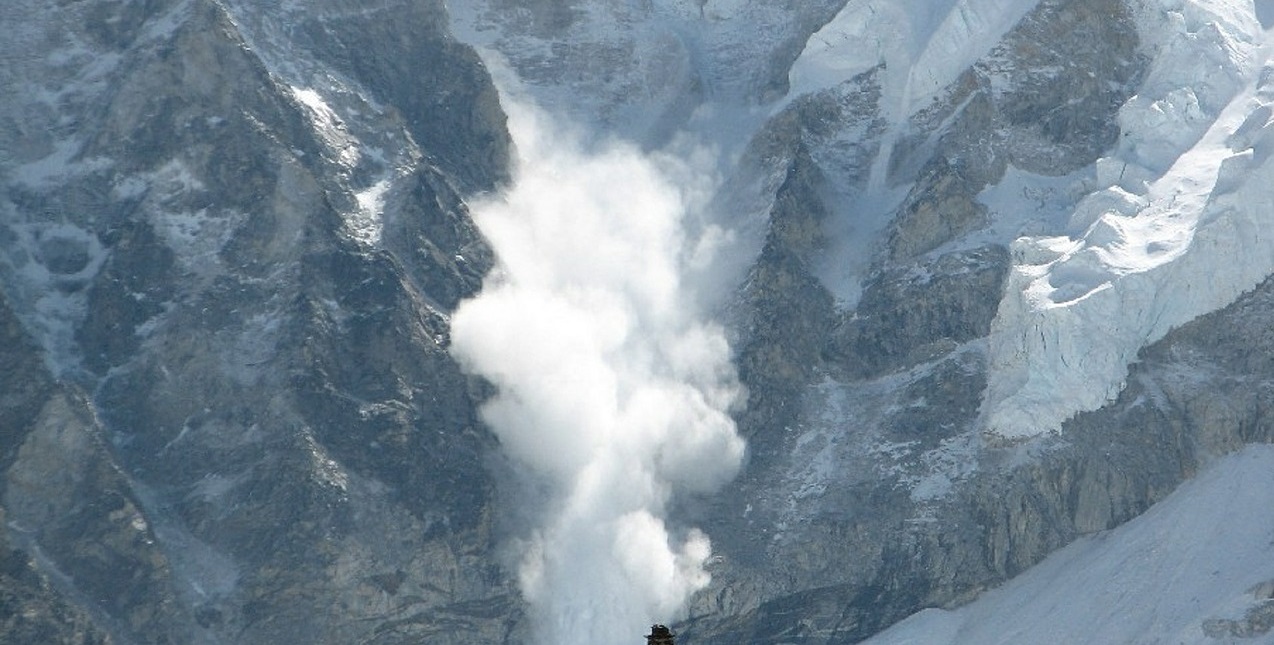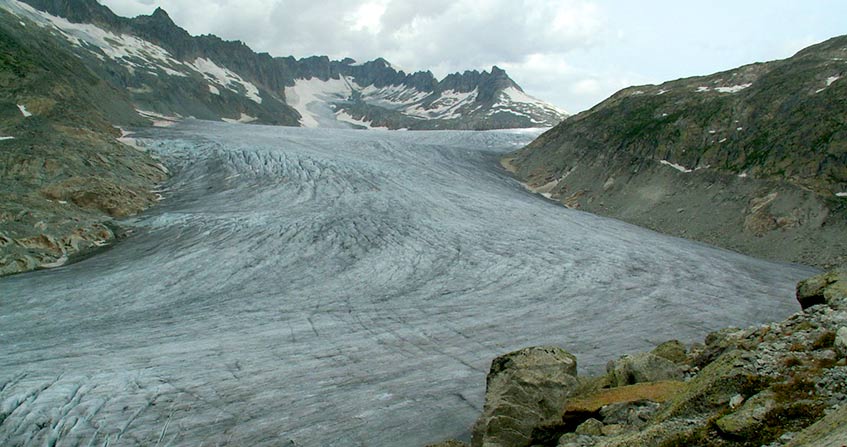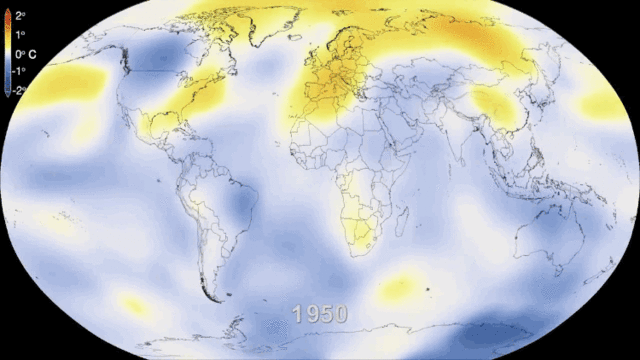气候变化的哨兵-冰川
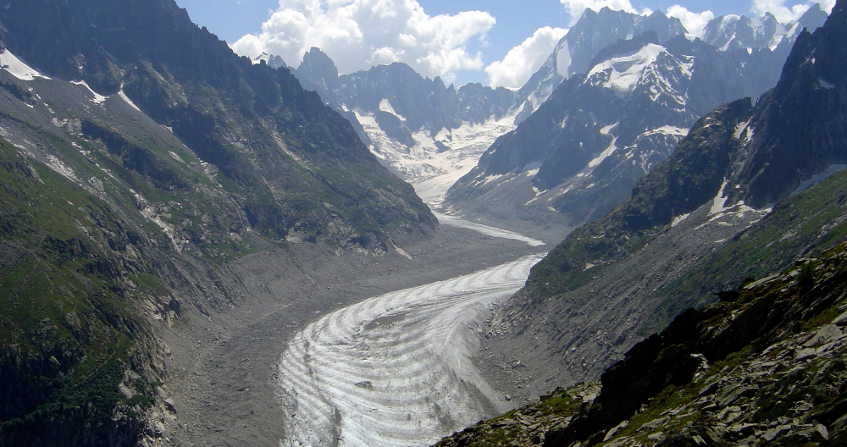
作为山地的真正标志,冰川是检测气候变化的主要工具。然而,冰川和气候之间的相互作用是复杂的,有时是间接的,而且在世界不同地区有很大的差异。冰川表面质量平衡(每年表面质量的增减)的测量或估计是了解过去一个世纪或几十年和当前波动的一个重要变量。这些测量结果为我们提供了过去 30 年来监测的非常高的冰川质量损失的信息。在模型的支持下,可以预测冰川的未来及相关影响,例如冰川起源的危害,湖泊或冰川瀑布。
大部分山地冰川的急剧下降是20世纪气候变化最明显的自然要素之一。因此,冰川的演变现在被认为是气候变化的一个强相关指标。在人迹罕至的区域、山区和极地等缺乏直接气象数据的情况下,冰川监测为我们提供了关于气候波动的直接信息。冰川的演变也产生了非常严重的后果:冰川是许多山区流域水文循环的主要组成部分,在科学研究中,它们对上世纪和未来海平面上升的贡献也占有重要地位。更不用说可能发生在地球不同地区的冰川/水文-冰川灾害了。
因此,有必要对冰川进行长期监测,以正确记录冰川与气候之间的关系,检测当前的气候变化,记录近期的气候变化并预测其演变和相关影响。
在这篇文章中,我们将主要关注世界上记录最详细的冰川之一:阿尔卑斯山冰川,以准确描述冰川的演变及其相关过程。
1. 通过质量平衡量化冰川和气候之间复杂的相互作用
虽然景观尺度上冰川的前进或后退是其演变的一个非常直观的证据。事实上,冰川变化与气候波动之间的联系因每个冰川而异。冰川由顶部流向山谷的冰组成,由于每个冰川的几何形状(大小、坡度、高度、盆地形状等)不同,所以不同冰川的流速相差较大。冰川的前缘对气候压力的反应是极端多变的天气。因此要破译每条冰川记录的气候信号,就需要测量和分析整个冰川的质量平衡。
1.1. 冰川的质量平衡
冰川是由积聚和消融这两个过程的此消彼长形成的。
积聚是指主要由于降雪导致的质量增加。在阿尔卑斯山,积雪主要是由于冬季降雪,有利于冰川堆积。在热带地区,部分降雪在夏季形成雨季。然而积雪的重新分布还取决于风、雪崩流等。
地表消融是指通过融化、升华(雪的蒸发)以及在某些情况下通过冰舌的解体以冰山的形式进入湖泊或海洋(被称为冰川的 “开裂”)而造成的质量损失。消融源于地表能量平衡,即冰川表面能量流的总和,以辐射的形式存在,但也以“敏感”热的形式存在(见焦点)。
因此,冰川的演变取决于质量增减之间的平衡,其差值就是冰川的质量平衡。因为天气条件随海拔高度与暴露程度而变化,总的质量平衡掩盖了冰川尺度上显著的局部差异。这些评估是在水文年度结束时进行的(在阿尔卑斯山从n年的10月到n+1年的9月底)。
冰川顶部在夏末(消融季节)仍然被积雪覆盖,其质量增加大于损失,这称为积累区,该区域的质量平衡为正。这就是著名的“永恒之雪”,其延伸范围从一年到下一年是不同的。
冰川下部的质量损失大于增加,质量平衡为负,称为消融区。在消融季节结束时,冬天的雪消失殆尽,往年的冰崭露头角。
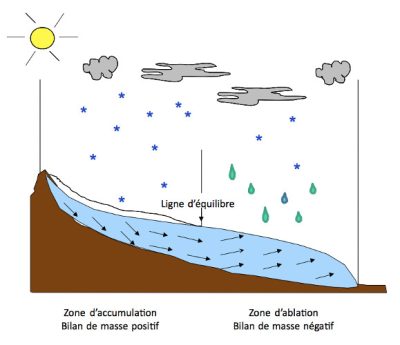
包括上部净积累区、下部净消融区和冰川的平衡线。冰川内部的箭头表示冰从上部流向下部。[© P. Wagnon](ligne dequilibre 平衡线 Zone daccumulation Bilan de masse positif 聚集区,质量平衡为正 Zone dablation Bilan de masse negative 消融区,质量平衡为负)
在水文年结束时,净积累区和净消融区的边界是冰川的平衡线(图1)。冰块沿斜坡的流动补偿冰川上层和下层之间的质量不平衡,从而达到上下层之间的质量均衡,这被称为冰川的 “动态”。因此,冰川的厚度由于积累、消融和流动之间的平衡而不断变化。
年度地表质量平衡与当地天气条件(降水、温度、湿度、风、辐射,见焦点)直接相关。因此从气候的角度来看,长期监测世界各地不同冰川的质量平衡参数意义深远。
1.2. 表面质量平衡的测量
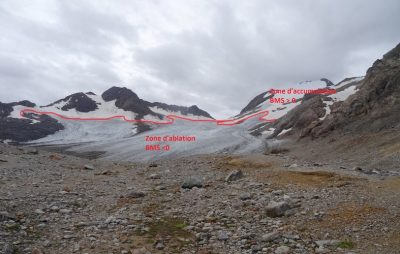
显示了积累区(雪)和消融区(流动冰川)之间的边界。 [© D. Six](Zone dablation 消融区 Zone daccumulation 堆积区)
在阿尔卑斯山的冰川上,冬季的积雪是人工测量的,而在春季则使用均匀分布在整个冰川上的表面冰芯进行测量(图3)。冬季沉积的雪量是通过确定前一年的水平来测量的。通过称重获得这些积雪的密度,从而可以将这些雪的高度转换成水的高度。此外,通过使用雪探针简单地测量雪深来增加测量网络的密度。在法国阿尔卑斯山的冰川上,每年有大约40个测量点的数据被记录下来(其中大约10个以冰芯的形式,其余的使用雪探针测量)。
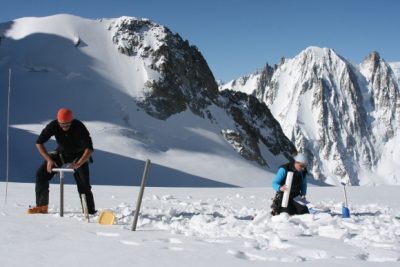
然后对冰芯进行称重,将雪深转化为水深(右)。[© P. Ginot]
移除量是通过前几年埋入的木桩或桩子(”标签“)的出现来衡量的(图2)。
在积累区,信标于春季被植入用于测量堆积的钻孔中。这些标桩将使我们有可能监测这一地区的夏季融雪情况。
在消融区,在冬季降雪之前的秋季,使用蒸汽探针在几个具有代表性的消融区位置放置10米长的信标。当这些信标在夏季出现时,可以在消融区的每个点测量冰的损失。
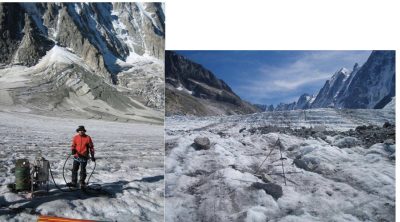
然后对冰芯进行称重,将雪深转化为水深(右)。[© Ch.Vincent]
积聚和消融测量用于计算冰川任何一点的质量平衡,用水位来表示(考虑到雪和冰密度的差异)。质量平衡表现为冰川获得或损失的水量。这种全球质量平衡是在水文年测量的。冰川的体积变化除以冰川总表面积,这样能够比较大小冰川(归一化),这就得出了平均水深或体隙(blade),也就是冰川表面积的年质量平衡。例如,如果冰川的质量平衡在1年内是-1米的水,这意味着冰川损失的水量相当于1米的水深分布在整个表面。
1.3. 冰川的质量平衡在不同地区对不同的气象参数敏感程度不同
冰川对气象变量的敏感性高度取决于区域条件。
- 在阿尔卑斯山,消融与大气温度密切相关。
- 靠近海洋的所谓“海上”冰川(如斯堪的纳维亚半岛)对降水的变化非常敏感。
- 世界上的一些地区,如喜马拉雅山脉西部的帕米尔,受到季风的严重影响,季风提供了大部分的降雨。
- 在非常干燥的地区,如安第斯山脉,升华作用(从物体的固相直接转化为气相)在消融中起着重要作用,并强烈影响着能量平衡,因为它消耗了大量的能量(而留给融化消耗的能量较少,参见焦点)。
- 位于高山(和极地)的所谓“冷”冰川,温度非常低(通常低于-10ºC),在开始融化前必须升温到0°C。因此,它们的质量平衡对气候变暖的敏感性要小得多。
极地冰盖的功能各异。融化能够完全以清除积聚在上部的冰块,冰川沉入海中,最终通过冰山的“崩塌”失去质量,南极冰盖的许多冰川就是这种情况。这些冰川的质量平衡对水流条件非常敏感(特别是在冰川的底部),而对表面融化过程的敏感程度要低得多。
因此,冰川对气候变化的响应在世界不同地区并不相同。
1.4. 冰川通过其质量平衡来适应气候
很多情况下,在对气候相应中,通过改变其几何形状(表面、长度和厚度)冰川流动起着重要作用。然而这种几何形状本身影响着总的质量平衡。事实上,如果气候变暖,冰川表面融化将增加,其质量平衡将减少,并且随着反应时间的推移,其前端将后退,冰川表面也因此在下部减少。由于这种表面积的减少位于消融区,冰川的总融化量将减少,其总质量平衡趋于零。因此,冰川的表面会根据气候条件进行调整,以达到平衡的状态。由于气候条件一直不稳定,这样的平衡只是理想状态下存在。
因此随着整个冰川的质量平衡的调整,几何参数并不是气候条件的最佳指标。与气候条件直接相关的是冰川上每个点的表面质量平衡,即在冰川的每个点上测量的积累和消融的总和(见焦点)。
2. 自末次冰期结束以来,高山冰川的波动情况(全新世)
在末次冰期期间,阿尔卑斯山的冰川占据了所有的主要山谷,并延伸到里昂平原。在最后一次冰川运动的高峰期过后,大约2万年前,冰川开始了非常强烈的退缩,导致它们变成了现在的构造,在这个被称为全新世的冰期,涵盖了过去大约1万年的时间。关于过去一万年的冰川波动,我们了解多少呢?
2.1. 全新世初期的碎片化和间接知识
在几千年的时间范围内,我们只能根据冰川冰碛(冰川在其消融区留下的各种大小岩石的堆积)的位置,泥炭地的花粉,以及对树木年轮的研究(树木气候学)间接地观察到冰川的连续进退。在距今7500和6500年前的全新世时期,高山冰川急剧下降,这很可能是过去一万年中最温暖的时期,那时的冰冻灾害比今天要少。
在距今2500-1900年前(罗马时代),冰川已经急剧下降,它们和现在一样小,甚至更小。但是全新世的后期也有几个寒冷的事件,包括14世纪到19世纪中期发生在阿尔卑斯山的“小冰河期”。
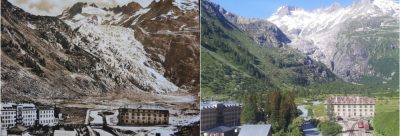
小冰河期阿尔卑斯山冰川的波动有相当多的记录,主要是通过古代故事和雕刻品。在这一时期,瑞士的阿莱奇冰川范围在1350年左右达到最大,然后在1580-1650年和1820-1850年期间再次达到最大。这期间的冰川比现在长3至3.5公里。
法国的海冰在1590至1680年和1820至1850年之间延伸显著,当时它的长度比2017年的长度长了近2.5公里,这些冰川随后在地貌上留下了冰碛沉积物,这是这一时期典型特征(图5)。
2.2. 小冰河期结束以来冰川的演变
自 19 世纪中叶以来,更多的定量观测使得我们能够更加详细地描述冰川的演变。特别是可以进行大量冰川长度(冰川前缘位置)的测量。由于旧的地形图和现有的实地调查,冰川变化告诉我们20世纪和21世纪气候特征截然不同。
不可否认,自1850年和小冰河期结束以来,阿尔卑斯山的绝大多数冰川都在减少,据估计冰川表面和冰川体积平均减少了一半左右。但平均值掩盖了显著的异质性,因为一些山丘损失了近60%的表面积(瓦努瓦斯和埃克林山丘),小冰川完全消失,其他冰川则支离破碎,而一些山丘只损失了20%至30%的表面积(勃朗峰山丘)。
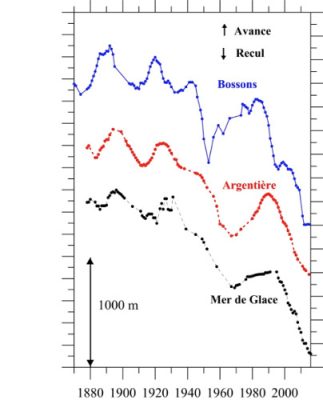
纵轴代表每条冰川随时间推移所损失的长度。可以区分出20世纪60年代至80年代的最后一次小的冰川洪水(锋面的重新推进)和过去30年剧烈的下降,并注意到冰川前缘反应时间的变化,波松冰川对地表质量平衡的变化几乎有一个瞬间的反应。[来源:Vallot,水和森林服务,GLACIOCLIM观察站]
(Avance 上升;Recul 下降;Bossons 波松;Argentirer 阿根蒂;Mer de Glace 冰海)
在此期间并不是持续下降。阿尔卑斯山冰川在过去的170年中经历了一些小的冰川洪水,特别是在20世纪60-80年代中期的最后一次冰川推进期间(图6)。
最后,在过去的30年里,冰川已经急剧减少。布朗峰山地的冰川和阿根蒂埃尔冰川已经后退了约750米,博桑斯冰川已经后退了1公里多。冰舌也变得相当薄了。自1990年以来,冰川的下部已经失去了近100米的厚度(典型的是在蒙特尼维尔火车到达站的地方)。
这些在景观中可察觉的几何变化(缩短和变薄)是冰川表面质量平衡变化的结果,响应时间从几年到几十年不等。因此,过去30年观察到的冰川的剧烈变化与自20世纪80年代中期以来质量平衡远小于零有关。
2.3. 过去30年来冰川质量的巨大损失
如上所述,冰川表面质量平衡比其长度更准确地代表了冰川对气候的响应。但质量平衡的测量是最近的(自20世纪50年代在法国开始),覆盖的冰川较少。世界上仅有大约三十个连续系列的质量平衡系列超过30年。
阿尔卑斯山国家(法国、瑞士、意大利、奥地利)有测量质量平衡的悠久传统。因此根据这些观测,最近的一项研究表明,1980-2010年期间,所有瑞士冰川的平均质量平衡为每年-0.62米(相当于其整个表面的平均水损失)。阿尔卑斯山的法国、奥地利和意大利的山脉情况相似。例如,1983-2016年间,冰海冰川和阿根蒂尔冰川的质量平衡分别为每年-0.90和-0.80米。自2003年以来,质量损失加速,阿尔卑斯山冰川的质量平衡损失更加严重,冰海冰川和阿根蒂尔冰川的质量平衡分别为每年-1.70和-1.40米。
在整个阿尔卑斯山脉400公里的范围内,每年的质量平衡波动是非常相似的。最近的一项研究显示了这一点,该研究比较了奥地利和法国之间阿尔卑斯山脉上6个大型冰川在过去50年里的质量平衡演变。
如1.3部分所述,冰川的总质量平衡不仅取决于气候条件,还取决于其表面的演变及其不平衡性。比较典型的情况是在2001-2016年同期,阿根蒂尔冰川(勃朗峰地块,19平方公里)和小圣索林冰川(大鲁斯山地块,3平方公里)每年分别流失1.30米和 2.00米的水。如果将年度质量平衡随着时间的推移相加,这些平衡差异就更加显着。因此在 2001-2016 期间,阿根蒂尔冰川的累积质量平衡为-20米的水,圣索林的累积质量平衡为-30米的水。
为了克服每个冰川特有的气候敏感性,研究站点冰川质量平衡的演变(在冰川的每个点)比研究冰川的整体质量平衡更有意义。1962-1983年冰川处于近平衡状态(在此期间几乎没有厚度变化),站点质量平衡显示,在接下来的1983-2002年期间,融化量每年增加0.85米的水,在最后的2003-2013年期间每年增加1.63米的水。
质量平衡为负是由于夏季变暖和消融季节延长2至3周,而近几十年来高海拔地区的雪量变化很小。
3. 超高海拔冰川:对气候变化的特殊反应
在阿尔卑斯山,几乎所有的山谷冰川都是所谓的温带冰川,也就是说冰川的温度接近冰的熔点。在阿尔卑斯山大约3500 m以上,冰被说成是“冷的”,即在非常低的温度下(位于4,300m的Dôme du Gouter冰川底部大约为-11℃,位于勃朗峰上的通道以及覆盖勃朗峰顶峰的小冰盖底部为-17℃)。冰川的温度取决于许多因素,包括海拔高度、暴露程度、地表积雪和冰川流量。尤其是当冰川在很高海拔处有一个堆积盆地时,例如波松冰川或Taconnaz冰川(勃朗峰地块),在高海拔处形成的冷冰在向下流动时会缓慢升温,并使冰川保持在“冷”状态,直到海拔远低于3500 m。
对这些高海拔寒冷地区的监测表明两个特点:一方面,冰的厚度在过去一个世纪里变化相对较小。另一方面冰川内部温度变化很大。
因此,Dôme du Gouter冰川(4,300米)的厚度在过去30年中只变化了几米。一项研究表明,自20世纪初Joseph Vallot和他的表兄弟在勃朗峰山地进行精确的地形测量以来,这个冰川(覆盖勃朗峰山顶的冰川)的厚度一直没有变化,不确定度为几米。然而这些保存在极高海拔地区的冰川丘陵只代表阿尔卑斯山的小部分地区。
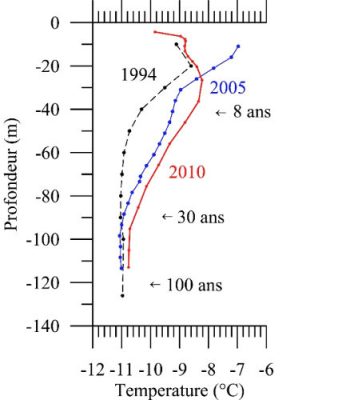
冰川的深度为 135 m,并且已经测量了从表面(深度 0 m)到岩床的温度。1994年至2010年之间温度上升。年龄对应于冰的年龄。[来源:改编自Gilbert和Vincent,[1]]
(Profondeur 深度;Temperature 温度)
尽管地表没有明显变化,但高海拔的冰川却受到大气变暖的影响,其内部温度升高。在这些高海拔冰川虽然没有气象站,但测得的温度曲线为该海拔高度的气候变化提供显著指标三这些措施仍然很少见。自 1994 年以来,在 Col du Dôme(4300 m,勃朗峰地块)从地表到135 m深度的冰芯钻孔中测量了温度,岩床附近的冰温度为-11℃。观测结果表明,在20年内(1994、2005 和2010进行测量),冰层在50 m深度迅速升温至1.5℃以上(图 7)[1]。实际上冰是过去的档案,因为温度的任何变化都会逐渐渗透到冰层中。因此垂直温度曲线使我们有可能重建近一个世纪以来大气温度的演变。重建得到的结论是高海拔地区的变暖与在平原地区非常相似。
4. 冰川变化的影响
气候变暖和消融加剧会对冰川产生不利影响。因此,寒冷的高海拔冰川变暖将改变所谓的“悬浮”冰川的稳定性,这些冰川位于非常陡峭的斜坡上,其稳定性归因于其基础温度为远低于零度(阻止了水循环与岩床接触)。当冰川底部的温度达到熔点时,这些冰川就会变得不稳定(冰川与岩床的摩擦力将大大降低)。这种情况经常发生在Taconnaz冰川(勃朗峰地块)[2]的上部区域。
冰川变化的另一个危害与湖泊有关,这些湖泊形成于冰川退缩留下的洼地,并由冰碛坝封闭,有时是不稳定的(冰川湖)。当这些湖泊没有出口或出口不足时,就会有突然排空的风险。这对山谷中的居民构成威胁。尼泊尔的许多冰川都被冰碛碎石覆盖,并在退却后留下了壮观的正面冰碛,被称为 “冰河”。
最后,在冰川中可以形成一些水(冰内湖),它是由与气候间接相关的复杂过程形成的。这些现象是罕见的,但是非常致命。1892年勃朗峰山地的Tête Rousse冰川内湖突然排空,造成圣热尔韦175人死亡。2010年,一个冰内湖重新形成并被及时发现:如果它破裂,可能会造成3000人死亡[3]。
5. 全球冰川退缩
20世纪国际上为更好地记录冰川的演变做出了努力。然而在全世界记录的25万个冰川中,只有大约30个有超过30年的质量平衡测量记录。因此冰川数据仍然非常少。航空照片和卫星图像可以部分地填补这些空白,通过多角度观测,准确地重建冰川的地形(这被称为摄影测量学),但该项技术始于20世纪50年代,并不包括所有的冰川地貌。卫星图像现在是预测冰川厚度变化的重要数据来源。但是这项技术从20世纪80年代初期才开始应用,2000年以后才普遍应用,如果要分析长时间序列还为时尚早。使用气象数据重建,以分析冰川对气候变量的敏感性,可以完善这套观测序列。
世界各地现有的所有观测和重建显示,山地冰川在小冰河期结束后普遍消退,大部分是在19世纪中期左右,尽管对一些山丘来说,早在18世纪中期就开始消退了。区域差异显著可能与气候变化的区域差异有关,但也与世界各地冰川的不同敏感性有关(1.3节)。例如,挪威海岸附近或新西兰西海岸附近的“海上冰川”对降水变化特别敏感。在喜马拉雅山脉,尼泊尔的冰川似乎对来自东南亚的季风非常敏感。安第斯山脉的热带冰川(玻利维亚、秘鲁)对厄尔尼诺现象非常敏感等。
除了少数罕见的情况,冰川目前正处于普遍消退。与阿尔卑斯山一样,阿拉斯加、热带安第斯山脉和巴塔哥尼亚的冰川正在遭受很大的质量损失。阿拉斯加的冰川在过去10年中每年损失约0.6米的冰层,而加拿大的北极冰川则损失了0.3至0.7米的冰层。热带安第斯冰川(特别是玻利维亚、秘鲁)40年来年平均损失60厘米至1米的冰层。非洲的冰川很快就会消失:乞力马扎罗山顶的冰川表面在1912年至2012年间从11.4km²缩减至1.8 km²,而在未来几十年内可能完全消失。
喜马拉雅冰川遭受的损失相对较小,在整个喜马拉雅山弧上平均每年冰层减少约 20 厘米。但这个地区通过卫星获得的精确数据不超过20年[4]。平均值掩盖了巨大的空间异质性:在喜马拉雅山脉以东(尼泊尔、不丹),2000-2016 年期间质量平衡在每年 -0.4到-0.7 m之间,而在山脉以西(帕米尔),质量平衡为负(每年约-0.1 m)。昆仑山脉(喀喇昆仑山以北)2000-2016年期间的质量平衡甚至略微为正(+0.15 m/年),这种情况很可能是由于降雨量增加。
关于全世界范围内冰川的演变概况,可以参考Francou和Vincent的书(2015)[5]。此外,世界冰川监测服务网站(http://wgms.ch)上也提供了世界各地观测到的冰川的详细数据。
6. 冰川的未来:未来几十年将大幅下降
由于对世界不同地区的冰川进行了长时间序列测量,现在已经可以模拟冰川的演变以重建其历史或确定其未来的演变,这些都是预测山区水资源或冰川对海平面影响的主要问题。
这些对未来的模拟基于气候背景,可以预测至21世纪末(有些甚至更久)温度和降水等参数的不同轨迹。但降水变化具有极大的不确定性,也会影响冰川变化的预测。从这些气候情景中,我们很好地了解了气候控制质量平衡,从而能够预测每个冰川的质量平衡,结合模拟冰川流动的动态模型来预测冰川未来的退缩和体积损失。
所有的模拟均表明,无论未来 20 年的气候情景如何,阿尔卑斯山的冰川在未来几十年都将急剧下降。事实上,冰川与目前的条件相比处于极不平衡的状态,其表面积与过去 30 年的气候条件相比太大了。即使气候条件在接下来的几十年里保持不变,冰川的表面积在恢复到稳定状态之前也会大幅减少。例如,在过去 20 年的平均气候条件下,阿尔卑斯山最大的冰川阿莱奇在恢复稳定状态之前会损失40%的体积。
然而,高精度建模需要所研究冰川的非常精确的信息(冰层厚度、基岩地形),这严重限制了对世界上少数冰川的研究。到 2100 年,在+2℃的相对乐观的情况下,阿莱奇冰川(现在长22公里)的前部预计将后退10公里,并可能失去90%的体积。
据估计,在阿尔卑斯山范围内,到 21 世纪末,现有冰川表面的 80% 至 95% 可能会消失,具体取决于所遵循的气候方案。这将影响欧洲部分地区的水资源(参见:“气候变化对积雪、高山冰川以及水资源的影响”)。
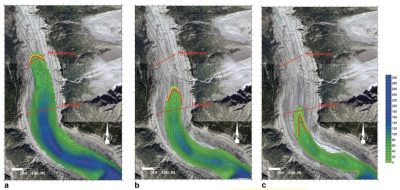
在阿尔卑斯山,海拔3500米以上没有积累区的冰川可能在2100年之前全部消失。尽管积累区的冰舌急剧缩短,但超过 4000 米的冰川远未消失。例如,预计未来30年冰海前沿将下降1至1.2公里(取决于所考虑的气候情景)(图 8)[6]。
参考资料及说明
封面图片:Public domain.
[1] Gilbert, A., C. Vincent, 2013. Atmospheric temperature changes over the 20th century at very high elevations in the European Alps from englacial temperatures, Geophysical Research Letters, 40, 2102-2108 DOI : http://dx.doi.org/10.1002/grl.50401
[2] Gilbert, A., C. Vincent, O. Gagliardini, J. Krug and E. Berthier (2015). Assessment of thermal change in cold avalanching glaciers in relation to climate warming, Geophys. Lett. Res. Lett., 42, doi:10.1002/ 2015GL064838. DOI: http://dx.doi.org/10.1002/2015GL064838
[3] Vincent, C., Garambois, S., Thibert, E., Lefebvre, E., Le Meur, E., Six, D. Origin of the outburst flood from Glacier de Tête Rousse in 1892 (Mont Blanc area, France). Journal of Glaciology, 56, 688-698. 2010. DOI: https://doi.org/10.3189/002214310793146188
[4] Brown F., E. Berthier, P. Wagnon, A. Kääb and D. Treichler. 2017. A spatially resolved estimate of High Mountain Asia glacier mass balances from 2000 to 2016. Nature Geoscience. 7 August 2017, DOI: 10.1038/NGEO2999
[5] Francou B. and C. Vincent. What’s new on the white planet. 2015. Editions Glénat. 143 p. EAN/ISBN : 9782344008157. Publisher link: http://nature.glenatlivres.com/livre/quoi-de-neuf-sur-la-planete-blanche-9782344008157.htm)
[6] Vincent, C., M. Harter, A. Gilbert, E. Berthier and D. Six. 2014. Future fluctuations of Mer de Glace, French Alps, assessed using a parameterised model calibrated with past thickness changes. Ann. Glaciol, 55(66), 15-24. doi: 10.3189/2014AoG66A050
环境百科全书由环境和能源百科全书协会出版 (www.a3e.fr),该协会与格勒诺布尔阿尔卑斯大学和格勒诺布尔INP有合同关系,并由法国科学院赞助。
引用这篇文章: SIX Delphine, VINCENT Christian (2024年3月14日), 气候变化的哨兵-冰川, 环境百科全书,咨询于 2024年4月20日 [在线ISSN 2555-0950]网址: https://www.encyclopedie-environnement.org/zh/climat-zh/mountain-glaciers-sentinels-of-climate-change/.
环境百科全书中的文章是根据知识共享BY-NC-SA许可条款提供的,该许可授权复制的条件是:引用来源,不作商业使用,共享相同的初始条件,并且在每次重复使用或分发时复制知识共享BY-NC-SA许可声明。







